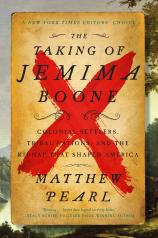The Taking of Jemima Boone: Colonial Settlers, Tribal Nations, and the Kidnap That Shaped America
Review
The Taking of Jemima Boone: Colonial Settlers, Tribal Nations, and the Kidnap That Shaped America
Many readers may not be aware that legendary pioneer and frontiersman Daniel Boone had a daughter who at one point was equally as famous, but for all the wrong reasons.
Matthew Pearl, stepping into the realm of narrative nonfiction for the first time, provides readers with a “Cast of Characters” flow chart at the start of the book, which makes it easy to keep track of the myriad of names that follow. In the prologue, he states that 13-year-old Jemima Boone’s kidnapping was not a stand-alone moment but part of a chain reaction that included another abduction, all-out military combat, and a courtroom drama that effectively put these preceding events on trial. THE TAKING OF JEMIMA BOONE addresses all of these occurrences.
"Matthew Pearl’s research is impressive, and his branching off into narrative nonfiction storytelling is a huge hit. I hope we haven’t seen the last of this kind of work from him."
Jemima is such a great character that you would swear she was a fictional creation and not a flesh-and-blood young woman. The Boones had led the way to Kentucky before the Revolutionary War as they balanced a desire to stake out a new phase of life against portents of violence, which were often ignored. On the afternoon of July 14, 1776, a mere 10 days after America’s Independence Day, Jemima and sisters Betsy and Fanny Callaway went for a canoe ride. Ironically, the trio’s fathers --- Daniel Boone and Richard Callaway --- were real-life adversaries, but the friction between them did not seem to negatively impact the friendship of their daughters. Following the girls' abduction, the finger-pointing between Boone and Callaway began, and that was just the tip of the iceberg.
The trouble between the American settlers and the Indian tribes can be traced back most recently to an incident known as Lord Dunmore’s War. When Hanging Maw, who was guiding a group of Shawnee braves, saw the opportunity to enact some revenge, he took it in the form of snatching up the three young ladies. He was laughingly quoted as saying, “We have done pretty well for old Boone this time --- got all his young squaws.”
Boone launched a strategic plan to get the girls back. Jemima knew in her heart that her father was the one man who was fit and able enough to rescue them. They were told by their captors that they were being brought to Shawnee towns. At that point they realized they were either going to lose their lives in a revenge ritual or call to war, or be chosen as “adoptees” for the tribe as replacements for those killed in combat or murdered in cold blood. Supposedly Hanging Maw fancied Jemima, which may be the primary reason they were kept alive.
The girls were eventually rescued but not without major consequences. Many times I felt like I was reading a work of fiction from James Fennimore Cooper, in which the role of Daniel Boone was played by Natty “Hawkeye” Bumppo. Matthew Pearl’s research is impressive, and his branching off into narrative nonfiction storytelling is a huge hit. I hope we haven’t seen the last of this kind of work from him.
Reviewed by Ray Palen on October 15, 2021
The Taking of Jemima Boone: Colonial Settlers, Tribal Nations, and the Kidnap That Shaped America
- Publication Date: October 4, 2022
- Genres: History, Nonfiction
- Paperback: 288 pages
- Publisher: Harper
- ISBN-10: 0062937804
- ISBN-13: 9780062937803




